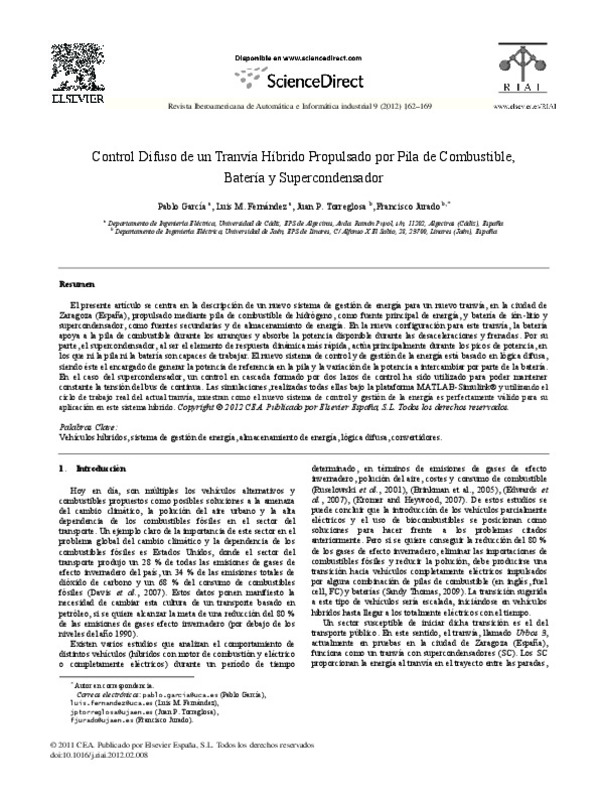Ballard fuel cell power. (2011). [En línea] http://www.ballard.com/files/pdf/Spec_Sheets/FCvelocity-HD6_SPC5101744-0G.pdf.
Bauman, J., & Kazerani, M. (2008). A Comparative Study of Fuel-Cell–Battery, Fuel-Cell–Ultracapacitor, and Fuel-Cell–Battery–Ultracapacitor Vehicles. IEEE Transactions on Vehicular Technology, 57(2), 760-769. doi:10.1109/tvt.2007.906379
CAF - Construcciones y Auxiliar de Ferrocarriles. (2011a). Urbos 3 [En línea]. http://www.caf.es/ingles/productos/urbos3_descripcion.php?urbos_prod=c.
[+]
Ballard fuel cell power. (2011). [En línea] http://www.ballard.com/files/pdf/Spec_Sheets/FCvelocity-HD6_SPC5101744-0G.pdf.
Bauman, J., & Kazerani, M. (2008). A Comparative Study of Fuel-Cell–Battery, Fuel-Cell–Ultracapacitor, and Fuel-Cell–Battery–Ultracapacitor Vehicles. IEEE Transactions on Vehicular Technology, 57(2), 760-769. doi:10.1109/tvt.2007.906379
CAF - Construcciones y Auxiliar de Ferrocarriles. (2011a). Urbos 3 [En línea]. http://www.caf.es/ingles/productos/urbos3_descripcion.php?urbos_prod=c.
CAF - Construcciones y Auxiliar de Ferrocarriles. (2011b). ACR System.[En línea] http://www.caf.es/ingles/id/sistema_acr.php.
Corbo, P., Corcione, F. E., Migliardini, F., & Veneri, O. (2005). Experimental study of a fuel cell power train for road transport application. Journal of Power Sources, 145(2), 610-619. doi:10.1016/j.jpowsour.2005.02.054
Davis S.C., Diegel S.W. and Boundy R.G. (2007). Transportation energy data book: Edition 27. U.S. Department of Energy.
Ehsani M., Gao Y., Gay S.E. and Emadi A. (2005). Modern Electric, Hybrid Electric, and Fuel Cell Vehicles: Fundamentals, Theory, and Design (Power Electronics and Applications Series). CRC Press.
Emadi, A., Young Joo Lee, & Rajashekara, K. (2008). Power Electronics and Motor Drives in Electric, Hybrid Electric, and Plug-In Hybrid Electric Vehicles. IEEE Transactions on Industrial Electronics, 55(6), 2237-2245. doi:10.1109/tie.2008.922768
Erdinc O., Vural B. and Uzunoglu M. A Wavelet-Fuzzy Logic Based Energy Management Strategy for a Fuel Cell/Battery/Ultra-capacitor Hybrid Vehicular Power System. Journal of Power System, 194, pp. 369-380.
Erdinc, O., Vural, B., Uzunoglu, M., & Ates, Y. (2009). Modeling and analysis of an FC/UC hybrid vehicular power system using a wavelet-fuzzy logic based load sharing and control algorithm. International Journal of Hydrogen Energy, 34(12), 5223-5233. doi:10.1016/j.ijhydene.2008.10.039
Fernandez, L. M., Garcia, P., Garcia, C. A., Torreglosa, J. P., & Jurado, F. (2010). Comparison of control schemes for a fuel cell hybrid tramway integrating two dc/dc converters. International Journal of Hydrogen Energy, 35(11), 5731-5744. doi:10.1016/j.ijhydene.2010.02.132
Gao, D., Jin, Z., & Lu, Q. (2008). Energy management strategy based on fuzzy logic for a fuel cell hybrid bus. Journal of Power Sources, 185(1), 311-317. doi:10.1016/j.jpowsour.2008.06.083
Garcia, P., Fernandez, L. M., Garcia, C. A., & Jurado, F. (2010). Energy Management System of Fuel-Cell-Battery Hybrid Tramway. IEEE Transactions on Industrial Electronics, 57(12), 4013-4023. doi:10.1109/tie.2009.2034173
Garcia, P., Fernández, L. M., Garcia, C. A., & Jurado, F. (2010). Comparative Study of PEM Fuel Cell Models for Integration in Propulsion Systems of Urban Public Transport. Fuel Cells, 10(6), 1024-1039. doi:10.1002/fuce.201000002
Hoogers G. (2003). Fuel cell technology handbook. CRC. Boca Ratón.
Li, C.-Y., & Liu, G.-P. (2009). Optimal fuzzy power control and management of fuel cell/battery hybrid vehicles. Journal of Power Sources, 192(2), 525-533. doi:10.1016/j.jpowsour.2009.03.007
Lisheng Shi and Crow M. L. (2008). Comparison of ultra capacitor electric circuit models. IEEE Power and Energy Society General Meeting - Conversion and Delivery of Electrical Energy in the 21st, pp. 1-6.
Marie-Francoise, J.-N., Gualous, H., & Berthon, A. (2006). Supercapacitor thermal- and electrical-behaviour modelling using ANN. IEE Proceedings - Electric Power Applications, 153(2), 255. doi:10.1049/ip-epa:20050096
Maxwell Technologies. (2011). [En línea] http://www.maxwell.com/.
Spyker, R. L., & Nelms, R. M. (2000). Classical equivalent circuit parameters for a double-layer capacitor. IEEE Transactions on Aerospace and Electronic Systems, 36(3), 829-836. doi:10.1109/7.869502
Padullés, J., Ault, G. ., & McDonald, J. . (2000). An integrated SOFC plant dynamic model for power systems simulation. Journal of Power Sources, 86(1-2), 495-500. doi:10.1016/s0378-7753(99)00430-9
Pukrushpan J. T., Stefanopoulou A. G. Peng H. (2002). Control of Fuel Cell Power Systems: Principles, Modeling, Analysis, and Feedback Design. Springer Verlag. Londres.
Ruselowski G., Wallace J.P., Choudhury R., Wang M., Weber T. and Finizza A. (2001). Well-to-wheels energy use and greenhouse gas emissions of advanced fuel/vehicle systems. North American analysis. General Motors, the Argonne National Laboratory, BP, Exxon Mobil, and Shell.
Sandy Thomas, C. E. (2009). Transportation options in a carbon-constrained world: Hybrids, plug-in hybrids, biofuels, fuel cell electric vehicles, and battery electric vehicles. International Journal of Hydrogen Energy, 34(23), 9279-9296. doi:10.1016/j.ijhydene.2009.09.058
Sikha, G., White, R. E., & Popov, B. N. (2005). A Mathematical Model for a Lithium-Ion Battery/Electrochemical Capacitor Hybrid System. Journal of The Electrochemical Society, 152(8), A1682. doi:10.1149/1.1940749
The MathWorks, Inc.SimPowerSystems (2011). [En línea]. http://www.mathworks.com/access/helpdesk/help/toolbox/physmod/powersys/index.html?/access/helpdesk/help/toolbox/physmod/powersys/&http://www.mathworks.com/access/helpdesk/help/helpdesk.html.
Srinivasan, V., & Weidner, J. W. (1999). Mathematical Modeling of Electrochemical Capacitors. Journal of The Electrochemical Society, 146(5), 1650-1658. doi:10.1149/1.1391821
Winston Battery Limited. (2011). [En línea] http://www.thunder-sky.com/.
Zubieta, L., & Bonert, R. (2000). Characterization of double-layer capacitors for power electronics applications. IEEE Transactions on Industry Applications, 36(1), 199-205. doi:10.1109/28.821816
[-]








